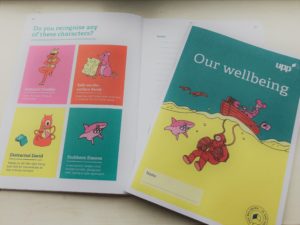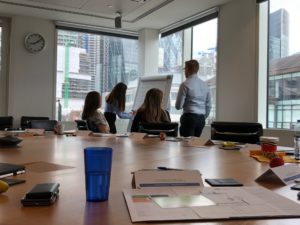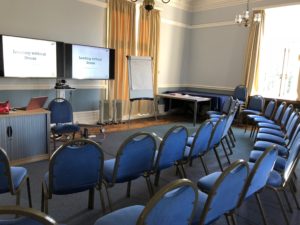University Partnerships Programme (UPP), The UK’s leading provider of on-campus residential and academic accommodation infrastructure has had an incredibly successful two years focussing on wellbeing, recently receiving a RoSPA Gold Award.
With health kiosks on site, suicide and mental health awareness training, and training for management in leading with stress – the company has become a leader in wellbeing at work.
Here, Health, Safety and Environment Director Mike Eady, talks to SHP about what it takes to evolve SHE into the bigger overarching wellbeing strategy…
It seems like you’ve had a successful start to your wellbeing programme; going back to the start, what was it that made you recognise a need for a wellbeing programme at UPP?
 Mike Eady (ME): “When I started at UPP I recognised that my job title was Health, Safety and Environment Director – but I wanted to find a way to bring those three things together and treat them as one. What traditionally happens is that safety gets 80% of the time, then 15% on health and 5% on environment or perhaps the other way around (with health and environment).
Mike Eady (ME): “When I started at UPP I recognised that my job title was Health, Safety and Environment Director – but I wanted to find a way to bring those three things together and treat them as one. What traditionally happens is that safety gets 80% of the time, then 15% on health and 5% on environment or perhaps the other way around (with health and environment).
“I wanted to make sure we did our operations in a safe way but I didn’t just want to focus on safety/ and health/ and environment – I wanted something overarching – and that to me was wellbeing. I spoke to a creative, marketing agency and thought of the process at UPP going on a journey to deliver a greater sense of wellbeing for our people and our students.”
So where do you begin in introducing a wellbeing initiative across a company like UPP?
(ME): “Our wellbeing initiative’s journey launched in 2016 and in 2016/17 we focused on safety and, in particular, behavioural safety. We always spoke about audits and RAMS – but I wanted to focus on what people can do to make a difference to their own safety – and we built a toolkit around this which we deployed over the course of that year.”
“The health kiosks have found some members of staff in their early 40s with incredibly high cholesterol. One person had to go to the GP and was prescribed statins to help reduce the likelihood of a heart attack.”
(ME): “A year later we launched the health pillar of the initiative which naturally followed on from behavioural safety. Behavioural safety looks at mind-set and how your state of mind and your behaviour influences your decisions around being safe and keeping others safe. Following on from this we wanted people to be able to understand their minds a bit more, so we started thinking about mental health. We didn’t want to look at mental health alone, but the healthy UPP person – by looking at physical health, mental health and workplace health.
“This phase of the wellbeing strategy involved face to face consultations and wellness kiosks (measuring height, weight, BMI, fat percentage, blood pressure, heart rate with professional advice and follow up appointments where needed. Some people were referred to their GPs for more urgent attention ) suicide awareness training, mental health and wellbeing training and training for managers, delivered by The Healthy Work Company, in partnership with Bruce Jenner of Loch Associates.
 “The wellbeing training involved 90-minute workshops for all staff reflecting on their own wellbeing, looking at how improved diet, exercise, sleep and thinking can lead to thriving at work. Staff looked at their own levels of stress, their capacity for stress and how to build resilience – through group and individual work. They also looked at signs and symptoms of the most common mental ill health conditions.
“The wellbeing training involved 90-minute workshops for all staff reflecting on their own wellbeing, looking at how improved diet, exercise, sleep and thinking can lead to thriving at work. Staff looked at their own levels of stress, their capacity for stress and how to build resilience – through group and individual work. They also looked at signs and symptoms of the most common mental ill health conditions.
“Leaders and managers attended courses looking at their own levels of stress, the way that their frame of reference (or view on the world) impacts the way they deal with negative life events, and how to start some of the more difficult conversations around mental ill health, with colleagues.
“For this they explored listening skills, non-judgemental listening and empathy. They also looked at stress sickness absence, the process around returning to work and reasonable adjustments.”
“Our vision is to build a culture of trust and mindfulness within our communities, where the environment, together with people’s wellbeing and safety is everyone’s responsibility.”
“The wellness checks gave us a real insight into the health of the workforce looking at health risks, including cholesterol, heart disease, diabetes, high blood pressure and kidney disease. We could then look at trends across different sites.
“I also delivered 5S training – a systematic way to improve the workplace – “Sort”, “Set In Order”, “Shine”, “Standardise” and “Sustain”.
“We are now turning to our third pillar which will look at how UPP can reduce its footprint on society by reducing the energy we use and the waste we produce.”
How challenging was it to get board buy in?

Exploring the signs and symptoms of stress at UPP Gracechurch Street.
(ME): “It was incredibly easy. One of the advantages of having a Health and Safety Director on the Group Board is that you get your say right at the top table. I made it clear from the beginning that I was going to do things differently and I wanted to change the way that UPP thought about health and safety – I wanted to make it fun and engaging and I told them that may not come cheap. We needed to invest in marketing, communication and technology to make it work – so I sketched out a budget for three years and presented it to the Chief Executive and the shareholders – and all I needed to do in return was develop a plan for the life of the strategy to show that we will touch a certain amount of people over the life of our mental health training, we will reduce our injury incidents rates from where it is to where it needs to be, and deliver an energy package that will take 10% off the energy pay bill – I essentially gave them a structured KPI approach and a business case – but mainly I wanted to do something different, something quite radical.”
“Following an attempted student suicide at one site, the suicide awareness course was very well received, with people exploring how to bring someone back from the point of crisis.”
(ME): “I didn’t have to present thousands of facts and figures – it was more about the power of conviction. It was about saying we are not doing enough in this space and our competitors are – and the big selling point for me was showing that it works for our customers – we have 16 university partners and in doing suicide awareness training and physical awareness training we made this available to the university partners and the students in order to demonstrate that if you invest in UPP as a business we care about you, and our students not just our own people. Our offering spread far wider and this was a great opportunity to differentiate ourselves with our competitors.”
“Getting buy in? I didn’t have to present thousands of facts and figures – it was more about the power of conviction.”
What about the buy-in down below, how did you get the message across and was it a challenge to get bums on seats?
(ME): “That’s a really good question. We have been running Director led “stop the clock sessions” which involves all eleven members of the group board sponsoring one or two sites and at a certain time on a certain day we stop the clock and we deliver a simultaneous multi media presentation. This way the same message is delivered at the same time and it was a great opportunity to lay out the wellbeing plan. This shows that it’s not just “Mike from Health and Safety” – this is the Chief Executive, the Finance Officer, the Construction Director all saying the same thing. If you are a UPP college it feels like this is a message from the business, not just health and safety.
“As those sites then go on to develop their wellbeing plans, if they need any support or if there are any blockers in the way then the Group Board Director who sponsors that site is there to help – and perhaps lend a bit of clout.

Training at Reading University
“We also do weekly Start Right meetings where everyone in the operational part of the business meets with their team leaders on a Monday and is taken though all the current issues around safety, and we have quarterly poster campaigns to keep all the messages alive.
“So, if you had to reflect on the last two years, where are the successes, what has worked well for UPP?
“We did a survey in 2017 and asked staff whether UPP cares about their wellbeing – at this point 63% believed or believed strongly that UPP did. This will be repeated, and we aim to get 80% this summer. We also received a RoSPA Gold Award this year based on our communications, marketing and theme around wellbeing.
“In terms of injury and incidents rate we set ourselves a target and we are ahead of that.”
So, the future! What’s next at UPP?
(ME): “We have now completed our current health initiatives and will be moving on to Mental Health First Aid Training in 2019.”
The Healthy Work Company supports organisations with their mental health and stress management training and consultancy needs. From policy and culture reviews, to training leaders and teams in how to look after themselves and each other, The Healthy Work Company offers business- driven, pragmatic support.
What makes us susceptible to burnout?
In this episode of the Safety & Health Podcast, ‘Burnout, stress and being human’, Heather Beach is joined by Stacy Thomson to discuss burnout, perfectionism and how to deal with burnout as an individual, as management and as an organisation.
We provide an insight on how to tackle burnout and why mental health is such a taboo subject, particularly in the workplace.

 Mike Eady (ME): “When I started at UPP I recognised that my job title was Health, Safety and Environment Director – but I wanted to find a way to bring those three things together and treat them as one. What traditionally happens is that safety gets 80% of the time, then 15% on health and 5% on environment or perhaps the other way around (with health and environment).
Mike Eady (ME): “When I started at UPP I recognised that my job title was Health, Safety and Environment Director – but I wanted to find a way to bring those three things together and treat them as one. What traditionally happens is that safety gets 80% of the time, then 15% on health and 5% on environment or perhaps the other way around (with health and environment). “The wellbeing training involved 90-minute workshops for all staff reflecting on their own wellbeing, looking at how improved diet, exercise, sleep and thinking can lead to thriving at work. Staff looked at their own levels of stress, their capacity for stress and how to build resilience – through group and individual work. They also looked at signs and symptoms of the most common mental ill health conditions.
“The wellbeing training involved 90-minute workshops for all staff reflecting on their own wellbeing, looking at how improved diet, exercise, sleep and thinking can lead to thriving at work. Staff looked at their own levels of stress, their capacity for stress and how to build resilience – through group and individual work. They also looked at signs and symptoms of the most common mental ill health conditions.

